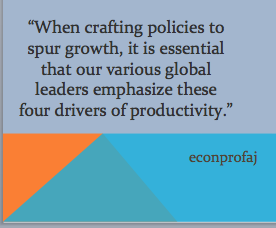When doing international comparisons of wealth and prosperity, one can distinguish rich from poor countries based on the following four factors: physical capital, human capital, natural resources, and technological knowledge. Countries that score high in all four factors are usually more productive and grow faster than countries that rate low in those same factors.
Physical capital per worker measures spending on infrastructure, equipment, and machinery in relation for each worker. Despite the relative small size of the U.S., their investment in physical capital far outnumbers any other country in the world. When you look at the level of automation and technology present in all aspects of American life, one can see how it makes our life much simpler. For instance, imagine doing complex calculus problems by hand, rather than computer. Instead of using Microsoft Word, imagine doing business reports with a pencil and paper. Imagine how hard it would be for a Proctor and Gamble factory worker to produce paper towels with their hands, rather than heavy machinery. The computer, Microsoft Word, and heavy machinery at Proctor and Gamble are all examples of physical capital. Acquiring physical capital requires a strong financial system in order for firms to make significant investments in expensive technology and equipment. The U.S. sophisticated financial system provides an edge over other countries. While China and India remain relatively poor countries, their investment in infrastructure and technology has fueled their rapid growth over the last couple of decades.
Human capital per worker refers to the knowledge and skill accumulated by the typical worker. When an individual increases their human capital, they are more productive and in demand by businesses. Typically, examples include earning a college degree, but it also includes attaining specialty certifications and hands-on training. As we shift from an industrial economy to a service-based economy, attaining certain skills can set you apart from others. That is why earning a college degree, particularly in a math or science discipline, will earn you much more money than a high school diploma. Countries that have more college graduates will yield higher salaries over those with less. Developing countries, such as China, Brazil, and India, have started to close the economic gap, particularly in their urban areas with improvements in educational outcomes
Natural resources per worker is the accumulation of resources for each worker. This includes land, energy, and water resources. Countries, such as the United States, that have an abundant source of natural resources have an edge on countries that have less natural resources, such as China. Unlike China that must pay high sums to the Middle East and Africa in order to meet their energy needs, the U.S. is able to offset those costs by boosting their domestic oil production. Also, Norway has a wealth of natural resources, which plays a role in their very high Gross Domestic Product (PPP) per capita of $53,471.
Technological knowledge is society’s understanding of the best way to produce goods and services. While similar to human capital, there is an important distinction. With technological knowledge, you are doing the teaching. However with human capital, you are trying to increase your knowledge base or skill level. For instance, a teacher developing curriculum is an example of technological knowledge. A student completing their junior year in high school is an example of boosting their human capital. The U.S. has a well-respected higher educational system that is the envy of many countries and its presence makes coming the U.S. very valuable to people across the world. Our free market system, which encourages individuals to pursue their career goals, encourage innovation and leads to high technological knowledge. Conversely, China’s economic model might not be sustainable in the long run because their system discourages innovation with inadequate protections of property rights.
When crafting policies to spur growth, it is essential that our various global leaders emphasize these four drivers of productivity.
